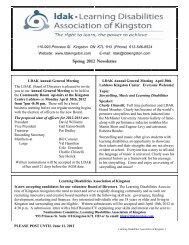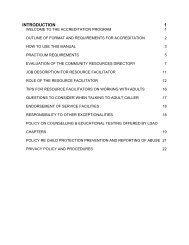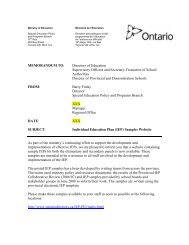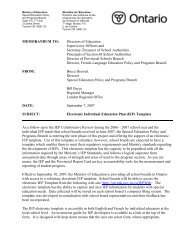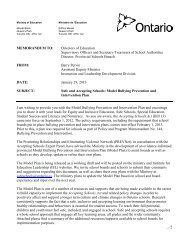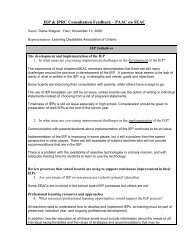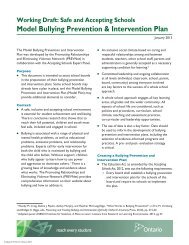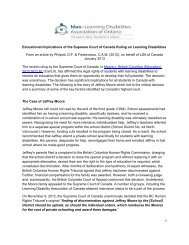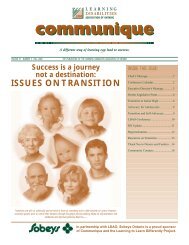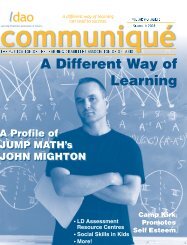Perspectives on the OPA Student Assessment Project - Learning ...
Perspectives on the OPA Student Assessment Project - Learning ...
Perspectives on the OPA Student Assessment Project - Learning ...
You also want an ePaper? Increase the reach of your titles
YUMPU automatically turns print PDFs into web optimized ePapers that Google loves.
Setting <strong>the</strong> Directi<strong>on</strong>According to <strong>the</strong> PMBOK Guide 1 , a project is “a temporary endeavorundertaken to create a unique product, service or result.” By <strong>the</strong> time Iwas hired, <strong>the</strong> Ministry of Educati<strong>on</strong> and <strong>the</strong> <strong>OPA</strong> had already definedat a high level <strong>the</strong> unique results <strong>the</strong>y wanted to accomplish. Keyoutcomes identified in early communicati<strong>on</strong>s from <strong>the</strong> Ministry ofEducati<strong>on</strong> and <strong>the</strong> <strong>OPA</strong> to school boards included: reduce wait timesfor professi<strong>on</strong>al assessments 2 for JK to grade 4 students; enhanceteacher capacity; and help students to succeed. I knew from experiencethat clear directi<strong>on</strong> would be crucial, and that <strong>the</strong> best way to developthat clarity would be to c<strong>on</strong>sult with <strong>the</strong> project stakeholders – thosewho have a “stake” in <strong>the</strong> outcome of <strong>the</strong> project. The <strong>OPA</strong> had already set up a solid governance structure to makedecisi<strong>on</strong>s, manage and advise <strong>the</strong> project. My first order of business was to facilitate a workshop with <strong>the</strong> project’sAdvisory Group and listen carefully to what <strong>the</strong>y had to say.The Advisory Group included representatives from schoolboard psychology, speech language pathology, occupati<strong>on</strong>al<strong>the</strong>rapy, <strong>the</strong> Ministry of Educati<strong>on</strong>, and <strong>the</strong> <strong>OPA</strong> Boardof Directors. I was impressed with <strong>the</strong> enthusiasm andinsights of <strong>the</strong> group as <strong>the</strong> expectati<strong>on</strong>s, c<strong>on</strong>cerns andhigh hopes for <strong>the</strong> future were expressed at that first halfdaymeeting. When it was over, we all understood for<strong>the</strong> first time that <strong>the</strong> project was not just about doingprofessi<strong>on</strong>al assessments. It was about making changes to<strong>the</strong> assessment process, starting with <strong>the</strong> process of decidingwhich students would benefit from a professi<strong>on</strong>al assessment, <strong>the</strong>n assessing <strong>the</strong> student, next supporting teachersin implementing assessment recommendati<strong>on</strong>s, <strong>the</strong>n evaluating <strong>the</strong> impact of interventi<strong>on</strong>s <strong>on</strong> student success, andmaking assessment process changes based <strong>on</strong> less<strong>on</strong>s learned.Working with <strong>OPA</strong>’s decisi<strong>on</strong>-making committee and <strong>the</strong> Ministry of Educati<strong>on</strong>, four project objectives were created:1. reduce wait times for students in junior kindergarten to grade IV requiring professi<strong>on</strong>al assessments2. enhance teacher capacity to provide effective programming for students provided with professi<strong>on</strong>al assessments3. improve literacy / numeracy for students provided with professi<strong>on</strong>al assessments4. sustain assessment process improvements for <strong>the</strong> l<strong>on</strong>g termTo fur<strong>the</strong>r elaborate <strong>on</strong> our directi<strong>on</strong>, I worked with <strong>the</strong> stakeholders to expand and clarify our visi<strong>on</strong> of <strong>the</strong> successfulachievement of <strong>the</strong> four objectives, and to define how we would measure success.Planning Our ApproachNow that I knew where we were headed, my thoughts turned to implementati<strong>on</strong>. How was I going to work with sucha diverse group of school boards to achieve <strong>the</strong>se objectives? I was fortunate in that <strong>the</strong> Council of Ontario Directorsof Educati<strong>on</strong> 3 special educati<strong>on</strong> projects had been launched <strong>the</strong> previous year. With much appreciated advice andguidance from Frank Kelly, <strong>the</strong> Executive Director of CODE, and project lead,Michelle Forge, I was able to scope out a basic approach to working with schoolboards.Ano<strong>the</strong>r serious order of business was to determine a fair way to divide up <strong>the</strong> $20milli<strong>on</strong> grant am<strong>on</strong>g <strong>the</strong> 72 school boards and 3 school authority groups with <strong>the</strong>irwide variati<strong>on</strong> in enrollment, geographic locati<strong>on</strong>, and language. We ran many<strong>Project</strong> Governance<strong>OPA</strong>Board ofDirectorsCore Committee<strong>Project</strong> Manager &TeamAdvisory GroupAccountablefor <strong>the</strong><strong>Project</strong>Decisi<strong>on</strong> Makers <strong>on</strong> Behalfof <strong>the</strong> <strong>OPA</strong> Board ofDirectorsResp<strong>on</strong>sible to CoreCommittee for Planning,Executi<strong>on</strong>, C<strong>on</strong>trol, ClosureInform <strong>the</strong> Decisi<strong>on</strong>sof <strong>the</strong> <strong>Project</strong> Managerand TeamPsychology Ontario 5



